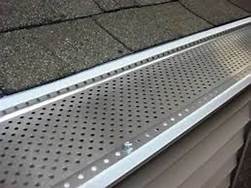Gutter Guards & Hangers
Tired of leaves and debris clogging your home’s gutters? Call NE Exteriors LLC and let we'll install the industry-leading micro-mesh gutter guards to reduce maintenance, prevent debris, and save you time and money. It’s time to say goodbye to gutter cleaning!
Gutter guards are an excellent way to cut back on gutter maintenance. Our micro-mesh gutter guards allow for up to 60 gallons per minute of water flow, so you won’t need to worry that they’ll be overwhelmed by heavy rains. Our micro-mesh guards also have a specialized protector for roof valleys, which are a problem area for every other type of gutter guard, yet the roof valleys are one of the most important areas to keep clean!
Here at NE Exteriors LLC, our number one priority is our customer’s experience. We like to customize our solutions based on a homeowner’s needs. That’s why we also offer a perforated aluminum gutter guard. Our perforated aluminum guard is an economical option that also offers terrific overall protection. Both of our gutter guard options are installed directly into the fascia, which has the added benefit of strengthening your gutter system. Say goodbye to gutter cleaning and call NE Exteriors LLC.
Here at NE Exteriors LLC, our number one priority is our customer’s experience. We like to customize our solutions based on a homeowner’s needs. That’s why we also offer a perforated aluminum gutter guard. Our perforated aluminum guard is an economical option that also offers terrific overall protection. Both of our gutter guard options are installed directly into the fascia, which has the added benefit of strengthening your gutter system. Say goodbye to gutter cleaning and call NE Exteriors LLC.
You might be surprised to learn that there are many types of gutter hangers. This means you can choose the gutter style of your choice without worrying whether it will be securely installed on your roof. In this blog, gutter and window replacement NE Exteriors shares an overview of the different types of gutter hangers.Hangers Secured to the Fascia Board — This is the most common gutter hanger style, compatible with both K-style and half-round gutters. One end holds up the gutter from its outer lip, while the other has a hollow piece where a fastener, usually a spike or long screw, is driven into. The fastener spans about half the width of the gutter trough.
Hidden Hangers — Hidden hangers are similar to standard gutter hangers, except that they are installed at the center of the gutter trough, making them invisible from the ground and creating a cleaner look.
Spikes and Ferrules — This type of gutter hanger uses a simpler mechanism. A ferrule is driven through both sides of the gutter trough, then a long spike or screw is driven through to the fascia board. The spikes need to be long enough to span the gutter trough and secure itself to the fascia. The two-hole installation method increases the risk of gutter leaks, which can allow rainwater to spill on siding and windows.
Exposed Brackets and Straps — This type of bracket uses U-shaped metal brackets that support the gutter trough underneath instead of penetrating it. A load-bearing strap is then attached to the fascia board. This bracket type reduces risk of corrosion, but the fasteners need to be properly installed, otherwise the brackets can be easily knocked off during periods of heavy downpour.
Hangers Secured to the Subroof — This is a variation of exposed brackets and straps. Instead of being secured to the fascia board, this type of hanger is secured to the roofing structure itself, usually under the shingles. While it’s more secure, it requires skill to install, and should not be left to inexperienced contractors.
T-Bar or T-Strap Hangers — T-bars resemble hidden hangers, but with a vertical metal strap riveted to its middle, forming a suspension system. The other end of the strap is fastened to the roof deck, which eliminates the need to use fasteners on the fascia board.


